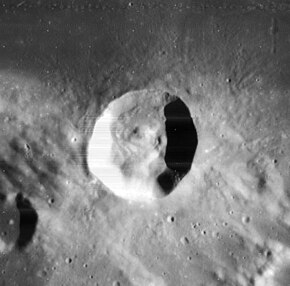


Lunar Orbiter 4 image
| |
| Coordinates | 16°18′N 16°00′E / 16.3°N 16.0°E / 16.3; 16.0 |
|---|---|
| Diameter | 27 km |
| Depth | 3.0 km |
| Colongitude | 344° at sunrise |
| Eponym | Menelaus of Alexandria |



Menelaus (/ˌmɛnɪˈleɪəs/) is a young lunar impact crater located on the southern shore of Mare Serenitatis near the eastern end of the Montes Hæmus mountain range. Its diameter is 27 km.[1] To the southwest is the small crater Auwers, and to the west-southwest is the even smaller Daubrée. To the northeast is a faint rille system named the Rimae Menelaus.
The wall of Menelaus is slightly irregular in outline, with a high, sharp rim and terraced inner walls. The interior has a high albedo that is prominent under high sun angles. There are several ridges on the floor. It also has a moderate ray system, with the most prominent ray aligned to the north-northeast across the Mare Serenitatis. The location of this ray and slightly off-center central peak suggest an impact at a relatively low angle.
Menelaus is named after the ancient Greek astronomer Menelaus of Alexandria.[1] Like many of the craters on the Moon's near side, it was given its name by Giovanni Riccioli, whose 1651 nomenclature system has become standardized.[2] Earlier lunar cartographers had given the feature different names. Michael van Langren's 1645 map calls it "Mariae Imp. Rom." after Maria Anna, the Holy Roman Empress.[3] And Johannes Hevelius called it "Byzantium (urbs)" after the city of Byzantium.[4]
By convention these features are identified on lunar maps by placing the letter on the side of the crater midpoint that is closest to Menelaus.
| Menelaus | Latitude | Longitude | Diameter |
|---|---|---|---|
| A | 17.1° N | 13.4° E | 7 km |
| C | 14.8° N | 14.5° E | 4 km |
| D | 13.2° N | 16.3° E | 4 km |
| E | 13.6° N | 15.9° E | 3 km |
The following craters have been renamed by the IAU.
